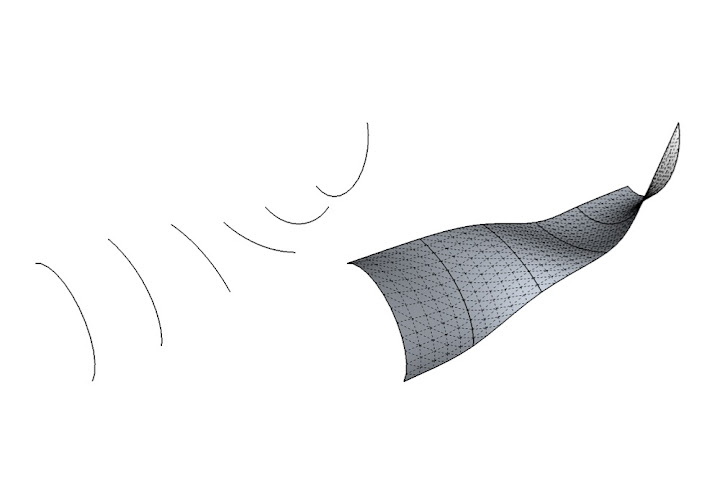The process of extruding one 2D profile such that it ends in another, different 2D profile is often called lofting. There’s no easy way to do this in plain ol' SketchUp, but there are plenty of plugins that make it possible. The one I’ve been obsessed with lately is called Curviloft; it's by the venerable Fredo6. If you need to learn about plugins in general, including how to install them, visit the plugins page on our website.
Curviloft lets you do three basic operations; which one you use depends on what you’re trying to accomplish. For the sake of brevity (and simplicity), I’m going to focus on only the first operation in this post: Loft By Spline.
The Basics
Let’s say you have two profiles that you want to connect together. The example below is super-simple: It’s a circle directly above a square. Here, I want to connect the two with a shape that goes directly between them. Curviloft’s Loft By Spline tool was made for just this kind of thing.
I start with two flat profiles (shapes) positioned one above the other.
With nothing selected, I activate Loft By Spline and click once on each shape. Because there are only two, it doesn’t matter which shape I click first. If there were more than two, I’d click in the order that I want to connect them, starting at either end. When both profiles are numbered, I click the green checkmark in the Curviloft toolbar (see below). This brings me into Preview mode, where I can see what I’m about to end up with.
The Curviloft toolbar is complicated; there’s no getting around it. The good news is that you don’t have to understand what all the controls do in order to use the tool. In Preview mode, you can just click things to see what happens. There's no shame in experimentation.
I like to fiddle with the Spline Method settings first (see below). This is where you control the shape of the vertical lines (splines) that connect the two profiles—in this case, the circle and the square. The three options that I find give the most interesting results are “Junction by connected lines”, “Bezier curves – Respect tangency (Method 2)” and “Junction by Orthogonal Bezier Curves”. By all means, try the other buttons, too; there’s gold in them thar hills.
Playing with the Vertex Matching controls also yields some useful options (see below). Here, you’re telling Curviloft how to decide which points on the perimeter of each profile should connect to one another. In this case, the circle has 24 endpoints and the circle only has four. The tool does its best to figure out the intermediate geometry, but the Vertex Matching settings let you provide guidance. For me, the most interesting button is the one on the far right; often, deselecting “Orientate contours to their best-fit box” seems to produce better results. Click it a few times to see what happens.
When you’re satisfied, hit Enter on your keyboard (or click the green checkmark on the toolbar) to finish generating the result.
Cool variation #1: Twisting
While you’re still in Preview mode, clicking on black part of your preview object opens yet another set of controls. The Properties of the Edited Junction window shows you more information about the connections in the operation you’re doing. My favorite widgets here have to do with twisting; they let you rotate either of your profiles (in this case, the circle and the square) by 15 or 90 degree increments. The result is an insanely cool twisting effect. Click the little right and left arrows and you’ll see what I mean. Addictive, no?
Cool variation #2: Offset profiles
Loft by Spline works great on profiles that aren’t lined up perfectly, too. Below, I’ve moved and rotated the circle.
Again, trying different Spline Method settings produces pretty wildly different results.
I dare you not to waste an afternoon playing with Curviloft. The other two tools in the set let you loft along a path and "skin" connected profile edges, but Loft by Spline is pretty powerful on its own. Remember that Curviloft is donationware, meaning that if you like it, you can contribute to its author; you'll find an option to do so in the Curviloft menu after you install it.
Here are some quick examples of shapes I whipped up while I was working on this post:
I've written about a couple of Fredo6's other terrific plugins in the past. RoundCorner gives you the ability to quickly and easily create rounds and fillets on almost any shape. FredoScale is a toolkit for stretching, bending, twisting and otherwise deforming your models in incredibly useful ways.
















9 comments :
Great to see this little tut to refresh our minds again! Thnx Aidan..
I have to wonder what "Newport Cigarettes" has to do with Sketchup. I don't mind promotion, but this is ridiculous.
I've waited 7 years for this puppy! Wow, it's here!
Wow, this is REALLY cool. This type of tools widens the creative possibilities so much! :)
Fredo's Curvi-Loft plug-in has been my favorite for a while now. I seem to be using it all the time. Anything I put in the warehouse that use it even a little gets a 'curvi-loft' tag.
We need to spread the word, I've seen many of my coleagues turn away from SU after trying to model organic shapes. With this plugin, I may even convince my firm to model more in 3D rather than in 2D.
It's almost as I've been blind and now I see the light. Thanks Aidan!
Ray Ban 3025 I believe this really is one of many a lot information for me personally. Ray Ban Aviator 3025
Thanks Fredo6
Thanks for reminding me of this plugin again. Great tut and thanks Fredo6 a bunch.
Post a Comment